What Are the Most Common Issues When Digitizing and Implementing Applications for Facility and Infrastructure Monitoring?
Gregor Obreza, Co-founder and CEO

Your company is ready to digitize and transition from paper forms to a modern solution for field operations. What should you watch out for?
What are the most common concerns during the transition to a new digital solution?
Managers responsible for maintenance teams often express the following concerns during digital transitions:
- Employee resistance to new technologies
- Fear regarding reliability of the new solution (connectivity issues, data storage, support responsiveness)
- Doubts about investment justification
- Integrations – compatibility with other systems and data exports
How to mitigate employee resistance?
Employees typically resist new applications for two main reasons:
- Adapting to a new user interface (bad past experiences with similar workplace tools).
- Increased monitoring of their movement and work.
In the case of TagPlan, we found that all users (including older ones) readily embraced the solution due to its ease of use. If a solution seems outdated, it’s likely that poor user experience, performance issues, poor support, and problematic updates will follow.
Despite using NFC technology (installed at each location) to verify presence (employees scan a tag), we’ve enhanced the user experience significantly. Workers instantly access specific tasks to be completed at that location. Supervisors can easily demonstrate proper maintenance and frequent visits, especially during audits or unexpected incidents.
Another strategy to reduce resistance is gradual implementation. Initially, implement the solution within a single department.
Example:
For water utility companies, first test the solution with your water network maintenance team. If successful, expand to other departments, such as wastewater treatment maintenance.
Ultimately, it’s human nature to initially resist new changes. Over time, trust builds as users realize the solution saves time and simplifies their tasks, although a minority may remain resistant.
How to verify the reliability of the solution?
At your initial meeting with the provider, ask for access to a trial version. This helps ensure the solution meets your requirements. During this period, test support responsiveness and receptiveness to your feedback.
Example:
TagPlan offers potential users a free trial designed to test the application under all conditions. Pumping stations and reservoirs often lack mobile coverage, rendering many solutions useless. TagPlan allows users to synchronize work orders beforehand, storing them locally on the phone. Users can operate normally offline, saving completed work to upload when coverage returns.
First-hand feedback is also vital. Request references from providers and talk to existing users about their experiences (both positive and negative). If the mobile app is listed on Google Play or the App Store, check its ratings and reviews.
How to justify the investment?
Many organizations already pay subscription or maintenance fees for existing software. Thus, investing in entirely new applications often raises questions.
Additional modules for existing systems often lack essential functionality, resulting in limited practical use. However, a new application can quickly enhance workflow, improve field visibility, and provide necessary proof during audits or emergencies. New software investments are often cheaper than modules for legacy systems.
An investment is justified if it saves your employees time, reduces hassles, simplifies tasks, or improves your organization’s reputation.
Example:
Water utility companies must regularly monitor conditions based on HACCP standards. If currently managed manually, calculate the total time spent planning, managing Excel sheets, printing, coordinating, and communicating via phone or email. Add the time spent retrieving past data for inspections or emergencies. Could improved visibility through better analytics enhance your service quality (e.g., better water quality)?
How about integrations with existing systems?
Every user prefers having all data in one place. However, such a universal system does not exist. With TagPlan, users can export data for analysis with other tools or storage in their current document systems. Custom API integrations with certain systems are available upon request if supported.
Remember, integrations are complex, time-consuming, and costly procedures requiring ongoing maintenance. Before opting for integrations, carefully consider potential data duplication.
Example:
Suppose you currently use System A, your ERP solution for managing operations, billing, inventory, etc. It supports field work orders but lacks flexibility, provides poor user experience, and inadequate support. You identify a specialized solution (Application B) for field tasks, chemical and physical parameter sampling, and observations, providing excellent user experience and support. However, you’re concerned about using two apps simultaneously and managing duplicate data, thus considering integration options.
First, assess if using two applications concurrently is genuinely problematic. Consider how many different apps you regularly use on your phone. The issue is likely poor user experience rather than having “another app.” If the new app is intuitive, it simplifies work.
Regarding data duplication, consider:
- What data do you need from System A in Application B and vice versa?
- Is weekly data export from Application B (Excel format) into System A sufficient? This approach significantly reduces cost and complexity.
- Which data from Application B requires immediate visibility in System A?
- Which data from System A requires immediate visibility in Application B?
- Would you like to initiate actions in System A visible in Application B (e.g., creating work orders)? Is the user experience in System A suitable for such actions?
For example, syncing locations from System A to Application B could be done once, with occasional updates, since these data rarely change.
A simple integration example is syncing data from Application B to System A (results from Application B visible in System A).
Two-way integrations are the most complex, involving continuous data exchange, requiring both providers to maintain API compatibility continuously.
Have any questions regarding these concerns?
Before implementing a new system for systematic infrastructure monitoring, address all these questions thoroughly. If your organization has any queries about usage, implementation, or experiences from current TagPlan clients, please contact us at [email protected] or call us at +386 41 563 804.

